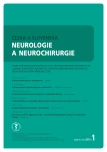Options for Therapy of Patients with Hemangiomas Grade III
Authors:
J. Musil; A. Mrlian; M. Duba; M. Smrčka
Authors‘ workplace:
Neurochirurgická klinika LF MU a FN Brno
Published in:
Cesk Slov Neurol N 2016; 79/112(1): 82-85
Category:
Short Communication
Overview
Meningioma grade III is one of rare tumors of the central nervous system. Unlike benign forms, grade III meningiomas are known for rapid aggressive growth and poor prognosis. Compared to benign forms, they tend to grow more intraaxially, infiltrating brain tissue. Resection, even though radical, must be followed by immediate adjuvant radiotherapy that allows better local control, especially in partially resected tumors. The disease continues to have poor prognosis and short survival time irrespective of the comprehensive treatment of this quite infrequent variant of the disease. Adjuvant radiotherapy could be combined with or followed by chemotherapy. Newly available data are to shed new light on this topic. Hormonal therapy and some aspects of molecular biology have been suggested as promising methods to improve patient prognosis. These new methods as well as stereotactic radiosurgery could provide suitable options for the treatment of malignant meningioma recurrence. The authors present case series of six patients with meningioma grade III. The group was analysed in terms of the diagnosis, extent of dissection, size of the residuum before radiation therapy as well as in terms of follow-up and median survival. Two patients underwent radical resection (Simpson 1), while four remaining underwent Simpson 3 resection. Afterwards, all patients underwent radiotherapy. Recurrence was managed individually. Therapy varied from reoperation through gamma knife treatment to palliation. Median survival was 18 ± 7 months. Any therapeutic approach should be as radical as possible while minimizing a risk of neurological deficit.
Key words:
meningioma WHO grade III – diagnostics – therapy – surveillance
The authors declare they have no potential conflicts of interest concerning drugs, products, or services used in the study.
The Editorial Board declares that the manuscript met the ICMJE “uniform requirements” for biomedical papers.
Sources
1. Kane AJ, Sughrue ME, Rutkowski MJ, Shangari G, Fang S, McDermott MW et al. Anatomic location is a risk factor for atypical and malignant meningiomas. Cancer 2011; 117(6): 1272– 1278. doi: 10.1002/ cncr.25591.
2. Wiemels J, Wrensch M, Claus EB. Epidemiology and etiology of meningioma. J Neurooncol 2010; 99(3): 307– 314. doi: 10.1007/ s11060-010-0386-3.
3. Bendszus M, Rao G, Burger R, Schaller C, Scheinemann K, Warmuth-Metz M et al. Is there a benefit of preoperative meningioma embolization? Neurosurgery 2000; 47(6): 1306– 1312.
4. Simpson D. The recurrence of intracranial meningiomas after surgical treatment. J Neurol Neurosurg Psychiatry 1957; 20(1): 2022– 2039.
5. Alexiou GA, Markoula S, Gogou P, Kyritsis AP. Genetic and molecular alterations in meningiomas. Clin Neurol Neurosurg 2011; 113(4): 261– 267. doi: 10.1016/ j.clineuro.2010.12.007.
6. Palma L, Celli P, Franco C, Cervoni L, Cantore G. Long-term prognosis for atypical and malignant meningiomas: a study of 71 surgical cases. J Neurosurg 1997; 86(5): 793– 800.
7. Pannullo SC, Fraser JF, Moliterno J, Cobb W, Stieg PE. Stereotactic radiosurgery: a meta-analysis of current therapeutic applications in neuro-oncologic disease. J Neurooncol 2011; 103(1): 1– 17.
8. Pollock BE, Stafford SL, Utter A, Giannini C, Schreiner SA. Stereotactic radiosurgery provides equivalent tumor control to Simpson Grade 1 resection for patients with small- to medium-size meningiomas. Int J Radiat Oncol Biol Phys 2003; 55(4): 1000– 1005.
9. Kollová A, Lisčák R, Semnicka J, Simonová G, Vladyka V, Urgosík D et al. Dlhodobé výsledky liečby meningeómov Leksellovým gamma nožom. Cesk Slov Neurol N 2010; 73/ 106(4): 415– 421.
10. Lee JH. Meningiomas: diagnosis, treatment and outcome. 1st ed. London (UK): Springer Science & Business Media 2009.
11. Schul DB, Wolf S, Krammer MJ, Landscheidt JF, Tomasino A, Lumenta CB. Meningioma surgery in the elderly: outcome and validation of two proposed grading scores systems. Neurosurgery 2012; 70(3): 555– 565.
12. Hug EB, Devries A, Thornton AF, Munzenride JE, Pardo FS, Hedley-Whyte ET et al. Management of atypical and malignant meningiomas: role of high-dose, 3D-conformal radiation therapy. J Neurooncol 2000; 48(2): 151– 160.
13. Goldsmith BJ, Wara WM, Wilson CB, Larson DA. Postoperative irradiation for subtotally resected meningiomas. A retrospective analysis of 140 patients treated from 1967 to 1990. J Neurosurg 1994; 80(2): 195– 201.
14. Al-Mefty O, Kadri PA, Pravdenkova S, Sawyer JR,Stangeby C, Husain M. Malignant progression in meningioma: documentation of a series and analysis of cytogenetic findings. J Neurosurg 2004; 101(2): 210– 218.
15. Al-Mefty O, Kersh JE, Routh A, Smith RR. The long-term side effects of radiation therapy for benign brain tumors in adults. J Neurosurg 1990; 73(4): 502– 512.
16. Jančálek R, Novák Z, Chrastina J, Slaná B, Feitová V. Radioterapii indukované meningeomy. Cesk Slov Neurol N 2011; 74/ 107(2): 191– 196.
17. Jääskeläinen J, Haltia M, Servo A. Atypical and anaplastic meningiomas: radiology, surgery, radiotherapy and outcome. Surg Neurol 1986; 25(3): 233– 242.
18. Milosevic MF, Frost PJ, Laperriere NJ, Wong CS, Simpson WJ. Radiotherapy for atypical or malignant intracranial meningioma. Int J Radiat Oncol Biol Phys 1996; 34(4): 817– 822.
19. Dziuk TW, Woo S, Butler EB, Thornby J, Grossman R, Dennis WS et al. Malignant meningioma: an indication for initial aggressive surgery and adjuvant radiotherapy. J Neurooncol 1998; 37(2): 177– 188.
Labels
Paediatric neurology Neurosurgery NeurologyArticle was published in
Czech and Slovak Neurology and Neurosurgery

2016 Issue 1
Most read in this issue
- Investigation of the Retinal Nerve Fiber Layer in Multiple Sclerosis Using Spectral Domain Optical Coherence Tomography
- Sympathetic Skin Response in the Diagnosis of Small Fibre Neuropaty
- Complications of Cranioplasty after Decompressive Craniectomy
- Indications for Decompressive Craniectomy
